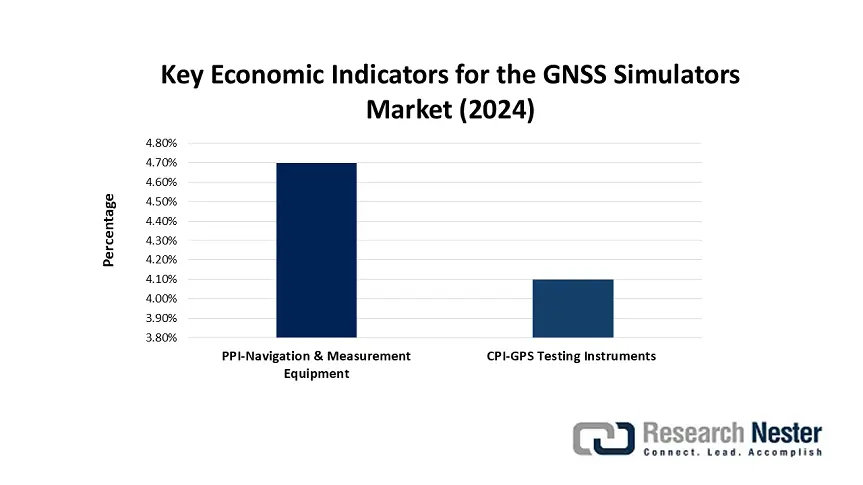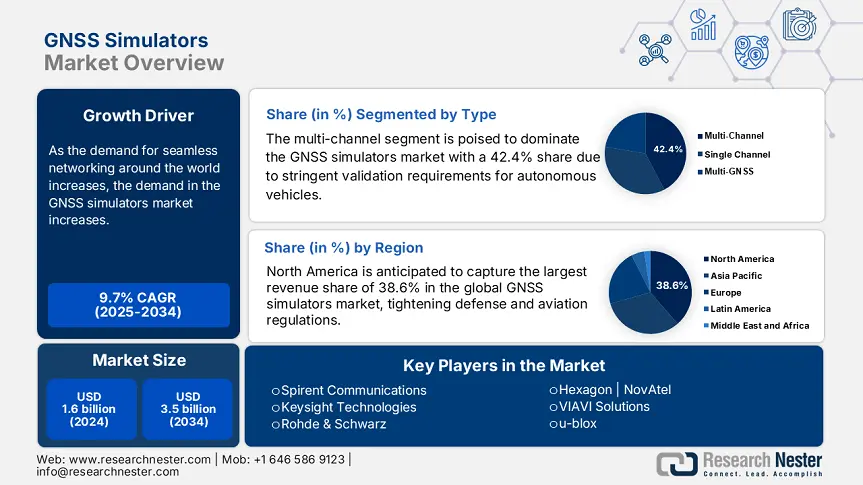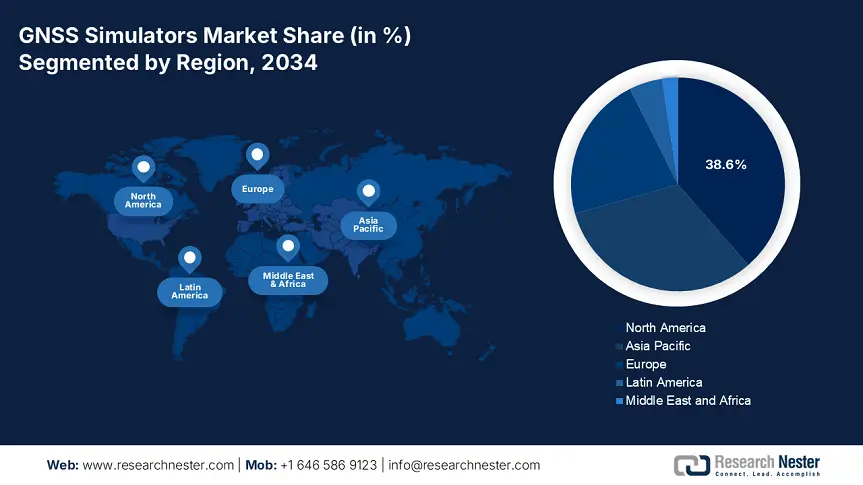GNSS Simulators Market Outlook:
GNSS Simulators Market size was over USD 1.6 billion in 2024 and is estimated to reach USD 3.5 billion by the end of 2034, exhibiting a CAGR of 9.7% during the forecast period, i.e., 2025-2034. In 2025, the industry size of GNSS simulators is estimated at USD 1.8 billion.
As the demand for seamless networking around the world is increasing, the need for advanced GNSS simulators is escalating. Based on the efficacy in testing and validating environmental conditions, vehicle movements, and signal interferences, this sector is gaining traction. This can be exemplified by the amplifying volume of global trade in such systems. In this regard, the U.S. Census Bureau reported that the U.S. and Germany collectively exported approximately $820.5 million of combined high-end GNSS-related hardware in 2023. Simultaneously, China dominates in importing 38.6% of global GNSS assembly-line machinery, while Taiwan and South Korea together produce and supply 72.3% of the advanced integrated circuits.

On the other hand, a substantial increase in payers' pricing for products available in the market is creating opportunities for next-generation technologies. Testifying to this, in 2023, the Bureau of Labor Statistics (BLS) in the U.S. recorded a 4.7% year-over-year (YoY) rise in the producer price index (PPI) for navigation and measurement equipment. As a result, the consumer price index (CPI) for GPS testing instruments for industrial operations also jumped by an annual 4.1%. In response, manufacturers are adopting cost-optimized production and tech-based integration to enhance the adoption rate in this sector. For instance, automation in assembly lines has reduced production lead times by 22.4% since 2020.

GNSS Simulators Market - Growth Drivers and Challenges
Growth Drivers
-
Cybersecurity and anti-jamming requirements: The market is witnessing remarkable compulsion in adoption due to a notable increase in spoofing and jamming threats. As evidence, between 2022 and 2024, a 300.6% spike in GPS spoofing incidents was reported by the U.S. Department of Homeland Security (DHS). To combat cyber breaches, global authorities are taking preventive measures by reinforcing encrypted testing solutions. For instance, the NIST CSF 2.0 (2024) and the ENISA Cybersecurity Act in Europe enacted stricter GNSS resilience criteria, which further drove a 15.4% YoY demand surge in this sector. Adhering to such regulatory updates, Spirent integrated AI-driven anomaly detection, reducing the false positives by 40.7%.
-
Autonomous vehicle and ADAS proliferation: The rapid penetration of advanced driver assistance systems (ADAS) in the automotive industry is fueling the rapid expansion of the market. This can be evidenced by the commercial success gained by BMW, which demonstrated 30.5% faster ADAS calibration using multi-constellation GNSS simulators, highlighting the true value of this technology. Regulatory requirements, such as the RTK simulation mandate for L4 autonomy by the National Highway Traffic Safety Administration (NHTSA), are also pushing automakers to integrate advanced GNSS systems to prevent accidents while enhancing the overall driving experience.
Challenges
-
Concerns about privacy and data security: Tightening regulations on data security, including the GDPR and DPDPA in Europe and India, are imposing unavoidable hurdles for the market. These restrictions upon cross-border test data sharing are also limiting the worldwide expansion of this sector. This can be exemplified by the u-blox facing an 8-month delay during its entrance into India, which was caused by data localization requirements.
-
Lack of adequate networking infrastructure: Emerging economies, such as India and Africa, often face adoption barriers for the market because of their underdeveloped 5G and RTK infrastructure. For instance, GNSS integration in Africa lagged behind global giants by three years on account of slow 5G deployment, as per the Global System for Mobile Communications Association (GSMA). To address this disparity, Spirent collaborated with local telecom providers, such as its partnership with MTN in South Africa, to deploy cost-effective simulator solutions tailored for infrastructure-constrained environments.
GNSS Simulators Market Size and Forecast:
| Report Attribute | Details |
|---|---|
|
Base Year |
2024 |
|
Forecast Year |
2025-2034 |
|
CAGR |
9.7% |
|
Base Year Market Size (2024) |
USD 1.6 billion |
|
Forecast Year Market Size (2034) |
USD 3.5 billion |
|
Regional Scope |
|
GNSS Simulators Market Segmentation:
Type Segment Analysis
The multi-channel segment is poised to dominate the market with a 42.4% share by the end of 2034. The stringent validation requirements for autonomous vehicles demand large-scale supply of reliable testing solutions and technology advances, which testifies to this leadership. In addition, 5G synchronization testing to gain compliance with the ITU-T G.8272 standard is also pushing service providers to adopt multi-channel GNSS systems. The segment's dominance is further consolidated with real-world efficiency gains, as demonstrated by Spirent's multi-constellation simulators that reduced ADAS calibration time by 30.6%.
Application Segment Analysis
The defense & military segment is estimated to hold the highest share of 38.8% in the market throughout the analyzed timeframe. The growing investments in PNT resilience against electronic warfare threats is the primary growth factor in this category. For instance, the U.S. Department of Defense (DoD) allocated $2.3 billion, dedicating a majority portion of these funds to GNSS simulation in contested environments, as per the 2025 PNT budget highlights. Furthermore, Lockheed Martin's M-Code GPS simulators demonstrate the segment's potential by reducing test cycles by 25.7%, creating opportunities to capitalize on this surge in demand for jammer-to-signal (J/S) ratio testing.
Our in-depth analysis of the global market includes the following segments:
|
Segment |
Subsegments |
|
Type |
|
|
Application |
|
|
Component |
|

Vishnu Nair
Head - Global Business DevelopmentCustomize this report to your requirements — connect with our consultant for personalized insights and options.
GNSS Simulators Market - Regional Analysis
North America Market Insights
North America is anticipated to capture the largest revenue share of 38.6% in the global GNSS simulators market over the assessed tenure. The tightening U.S. DoD and Federal Aviation Administration (FAA) regulations, mandating advanced testing features for the defense and aerospace industries, are amplifying demand in this sector. This can also be testified by major contracts with industry leaders, such as SpaceX, for high-precision simulation solutions. The region is also witnessing AI-assisted price reductions, which are making advanced GNSS testing tools more accessible while maintaining compliance with rigorous regulatory standards.
The U.S. is augmenting dominance over the regional market on account of rapid defense modernization and 5G networking expansion. This can be evidenced by the $2.8 billion 5G funding from the Federal Communications Commission (FCC). Besides, the $65.7 billion broadband initiative from the National Telecommunications and Information Administration (NTIA) is also driving demand for GNSS synchronization in telecom infrastructure. Furthermore, in 2024, the DoD invested $1.6 billion in extensive R&D for GPS modernization, which underscores the presence of favorable strategic and targeted capital influx to bring advancements in resilient PNT systems, positioning the U.S. as the core growth engine for North America.
Canada is also establishing a strong foundation to contribute to the continuous growth in the GNSS simulators market in North America, as substantial federal investments and telecom mandates act as the pillars for the country in this sector. As evidence, the Innovation, Science and Economic Development (ISED) of Canada allocated $1.7 billion to AI & IoT integration for cultivating a nationwide smart infrastructure. In addition, the $500.5 million Quantum Initiative is accelerating the adoption of PNT resilience, while the Canadian Radio-television and Telecommunications Commission (CRTC) updated 5G synchronization guidelines that fuel validation demand.
APAC Market Insights
Asia Pacific is predicted to exhibit the fastest growth by the end of 2034, owing to rapid QZSS and Galileo expansion, 5G deployment, and booming autonomous vehicle development. In addition, supply chain-related advantages are contributing to the domestic expansion of this sector. For instance, till 2024, Sony Semiconductor was supplying 70.5% of GNSS ICs demand across Asia in support of Japan Electronics and Information Technology Industries Association (JEITA) testbed partnerships. Moreover, Japan Patent Office (JPO) patents for AI-integrated simulators rose by 40.3% in 2023, which signifies to the future advances in this landscape.
China is estimated to lead the regional GNSS simulators market with a 45.6% revenue share by 2034. The country's proprietorship is fueled by its BeiDou-3 global navigation system, which is backed by the $3.1 billion investment from the Ministry of Industry and Information Technology (MIIT). Additionally, the massive 5G/6G infrastructure rollout, targeting 500.5 million base station installations by 2030, is contributing to the enlarging consumer base for this merchandise. On the other hand, the nation's thriving automotive sector accounts for 30.5% of demand, driving adoption through L4 autonomy testing that is supported by MIIT’s $1.9 billion ADAS fund.
India is remarkably benefiting the APAC GNSS simulators market as an epicenter of sustainable demand and tech-based evolutions. The country's indigenous Indian Regional Navigation Satellite System (IRNSS) program is empowering the deployment of Navigation with Indian Constellation (NavIC), which spurred a 20.5% surge in testing solutions. The government supported this cohort with a $650.5 million investment with an aim to deploy more than 10.7 million IoT devices by the end of 2030. Besides, accelerating adoption in smart city projects and the localization of data centers amplify cash inflow and ensure compliance with data sovereignty laws in this sector.
Government Investments, Policies, Budgets & Funding
|
Country |
Year |
Initiative / Policy |
Budget / Funding (Million) |
Key Focus |
|
Australia |
2025 |
Quantum & GNSS Resilience Program |
$50.4 |
Defense & critical infrastructure |
|
South Korea |
2024 |
KPS Testbed for Autonomous Vehicles |
$90.5 |
Automotive & drone navigation |
|
Malaysia |
2025 |
ASEAN GNSS Cooperation Initiative |
$20.3 |
Cross-border standardization |
Europe Market Insights
Europe is poised to establish itself as a powerhouse in the global GNSS simulators market between 2025 and 2034. The region's persistent performance in this sector is highly attributable to the magnifying automotive industry and substantial government investments. Besides, the European Space Agency (ESA) affiliated Galileo program and robust regulatory support is also contributing to the region's progress in this category. As evidence, the Horizon Europe program dedicated €650.6 million to Galileo/EGNOS testing infrastructure, which further propelled demand for high-precision simulators. Moreover, the enactment of the ETSI EN 303 613 regulation garnered €120.5 million in simulator investments.
Germany is expected to retain dominance over the Europe GNSS simulators market with a 28.5% revenue share by 2034. Its leadership in ADAS and defense technologies is backing this regional leadership. For instance, the reliance of the country's automotive industry on simulators for 5G/ADAS validation accounted for 35.5% of demand. This is further supported by the €1.5 billion investment in Galileo/5G testing, under the affiliation of the Federal Ministry for Digital and Transport (BMDV). On the other hand, defense modernization, including €800.4 million allocation for anti-jamming PNT systems and €500.3 million from the Europe Digital Innovation Fund for GNSS R&D, is cementing the nation’s role as an innovation hub.
The UK is expected to account for a notable 22.4% revenue share owing to strong emphasis on satellite navigation and smart city initiatives. In this regard, the Department for Science, Innovation and Technology (DSIT) allocated £850.5 million to bring advances in PNT technologies. This is further fueling this sector with a 30.4% YoY increase in nationwide simulator adoption. Such targeted investments position the UK as a key hub for urban mobility and next-generation navigation systems.
Country-wise Government Provinces
|
Country |
Year |
Initiative / Policy |
Budget / Funding (Million) |
Key Focus |
|
Spain |
2025 |
Quantum-GNSS Security Initiative |
€80.3 |
Defense & secure navigation |
|
Italy |
2025 |
Southern Europe GNSS Backup Network |
€100.4 |
Resilient PNT infrastructure |
|
Russia |
2024 |
Arctic GNSS Infrastructure Boost |
₽20.4 |
Polar navigation & logistics |

Key GNSS Simulators Market Players:
- Company Overview
- Business Strategy
- Key Product Offerings
- Financial Performance
- Key Performance Indicators
- Risk Analysis
- Recent Development
- Regional Presence
- SWOT Analysis
The current dynamics of the market indicate significant control from pioneers in Japan, who are leveraging their expertise in wireless power transmission (WPT) and precision electronics. Particularly, TDK, Mitsubishi Electric, and Panasonic are enhancing their R&D capabilities in magnetic induction and resonant charging to enhance GNSS testing solutions. On the other hand, global tech firms are utilizing strategic partnerships and standardization goals to strengthen their position in this sector. Moreover, with increasing demand for high-precision GNSS testing in EVs and smart devices, key players are expanding their territory on a global scale.
Here is a list of key players operating in the global market:
|
Company Name |
Country of Origin |
Estimated Market Share % |
|
Spirent Communications |
UK |
15.2 |
|
Rohde & Schwarz |
Germany |
13.8 |
|
Hexagon AB |
Sweden |
10 |
|
VIAVI Solutions |
USA |
8 |
|
Keysight Technologies |
USA |
6.5 |
|
Orolia (Spectracom) |
France |
xx |
|
CAST Navigation |
USA |
xx |
|
Syntony GNSS |
France |
xx |
|
u-blox |
Switzerland |
xx |
|
Accord Software & Systems |
India |
xx |
|
RACELOGIC |
UK |
xx |
Below are the areas covered for each company in the market:
Recent Developments
- In March 2024, Spirent Communications launched its SimORBIT Software Suite, enhancing multi-constellation GNSS testing with cloud-based simulation for autonomous vehicle (AV) developers. The software reduces testing time by 30.4%, contributing to a 15.6% revenue increase for Spirent in the 1st quarter of 2024.
- In February 2024, Keysight Technologies introduced its UXM 5G+GNSS Test Solution, integrating 5G NR and GNSS simulation for IoT and smart city applications. The solution, compliant with 3GPP Release 17 standards, drove a 12.3% YoY revenue increase during the 1st quarter of 2024.
- Report ID: 7907
- Published Date: Jul 17, 2025
- Report Format: PDF, PPT
- Get detailed insights on specific segments/region
- Inquire about report customization for your industry
- Learn about our special pricing for startups
- Request a demo of the report’s key findings
- Understand the report’s forecasting methodology
- Inquire about post-purchase support and updates
- Ask About Company-Level Intelligence Additions
Have specific data needs or budget constraints?
Frequently Asked Questions (FAQ)
GNSS Simulators Market Report Scope
FREE Sample Copy includes market overview, growth trends, statistical charts & tables, forecast estimates, and much more.
Connect with our Expert
 Inquiry Before Buying
Inquiry Before Buying

